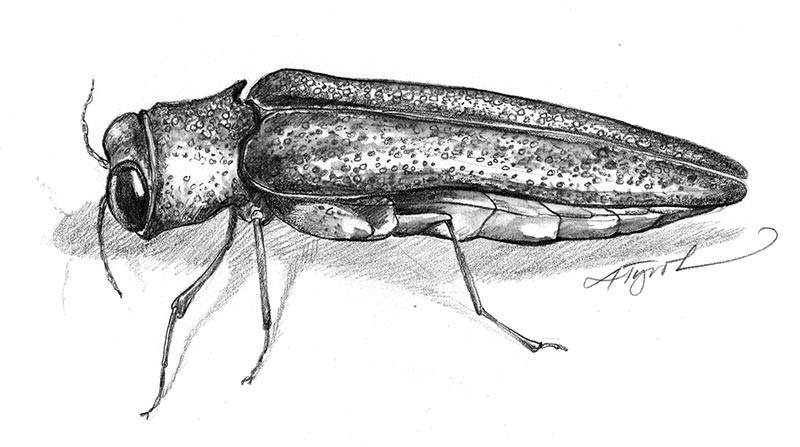
Jim Fuller, a former park ranger at Vermont’s Grand Isle State Park, described this interaction with a tourist from New Jersey, when he confiscated their out-of-state firewood.
Ranger Jim: "We are trying to keep the forests clear of invasive insects.”
Tourist, as beetle fell from firewood: “you mean like that one there?"
In this instance, the hitchhiking insect proved to be an innocuous flathead borer. However, Jim’s anecdote illustrates a major challenge for forest stewards around the region, and especially for officials tasked with managing tourist areas. Invasive insects often hide in wood. Every time someone moves firewood from one area to another, especially when they transport it over long distances, there’s a risk of a new forest infestation.
The emerald ash borer (EAB) is a poster bug for this risk. Recently, this highly destructive half inch long metallic green beetle has reached Orange County, Vermont, and transported wood is one of the potential causes. EAB kills all American ash species, and in our region’s forests, where white ash is common, the insect has the potential to bring about radical change in our ecosystem and loss of timber value, as well as die-offs of yard and street trees. According to State Entomologist Judy Rosovsky, the Orange County infestation was noticed by an observant forester working on private land. He sent photographs to vtinvasives.org, and they were able to confirm his suspicions.
The time between first infestation and tree death is remarkably short – typically, one to four years. The damage occurs as larvae chew their way through the tree’s sapwood, zigging, zagging, and leaving frass-filled serpentine pathways in their wake. As they sever vessels beneath the bark, the effect is similar to someone ringing a trunk with a saw.
Part of the challenge of managing EAB, is that it is hard to detect, especially in the early stages. Generalized symptoms of ill health in ash trees such as crown dieback are often early signs, but other conditions can also bring these same symptoms. A frequently cited diagnostic is the one eighth inch, D-shaped hole that an adult beetle leaves as it emerges through the tree bark (adults emerge between May and midsummer). However, in practice, these holes can be very difficult to find and identify. When Rosovsky and her colleagues are inspecting an area, “we look for woodpeckers’ pecks and flecks – flecks of blond bark where the birdy feet have kicked off bark, and pecks just into the wood, where the insects hang out.”
Approximately five percent of Vermont’s trees are ash, so I feel some stress at the news of EAB’s arrival (one small consolation – mountain ash, a beautiful tree of high elevations, is not a true ash and is immune). However, as my father liked to say, “if you must panic, have an organized panic,” and so I asked Rosovsky how people in areas infected by the insect should respond to inevitable tree loss.
In Vermont, state officials are developing a plan to discern the extent of the infestation. Road-side ash inventories will likely be components of this effort so that vulnerable areas can be managed to prevent damage by falling trees. In the meantime, Rosovsky quoted her colleague Barbara Schultz, the forest health program manager at Vermont Forests, Parks and Recreation: “don't panic and don't cut all of your ash trees.” Despite the grim prospects, not all the trees will die immediately. According to Rosovsky, “if you are further than five to ten miles from the infestation, you are not at immediate risk.”
Unfortunately, towns and property owners should plan for reduced dependence on ash in their landscapes. For example, at Saint Michael's College where I work, we are considering our options. About 85 ash trees grace our campus with many more scattered through the natural area. According to Alan Dickinson, Associate Director of Grounds, EAB can be checked by injecting insecticides into the soil every other year, but this is an expensive option that at most, can protect individual trees.
Preventing the movement of infested wood is the highest priority for slowing the spread of this and other forest pests. Left to their own devices, EAB infestations in Maryland spread at a rate of only a half mile per year. However, as noted in the Vermont Department of Forests, Parks, and Recreation literature, “…all stages of the insect can travel 65 mph down the interstate inside infested wood!”
All bordering states and Quebec have emerald ash borer infestations. With beetles also found in Orange, Washington, and Caledonia Counties, no Vermonter lives more than 70 miles from an infestation. I won’t be felling the green ash from the corner of my yard any time soon, but sadly, neither will I plan on planting any new trees.


Discussion *